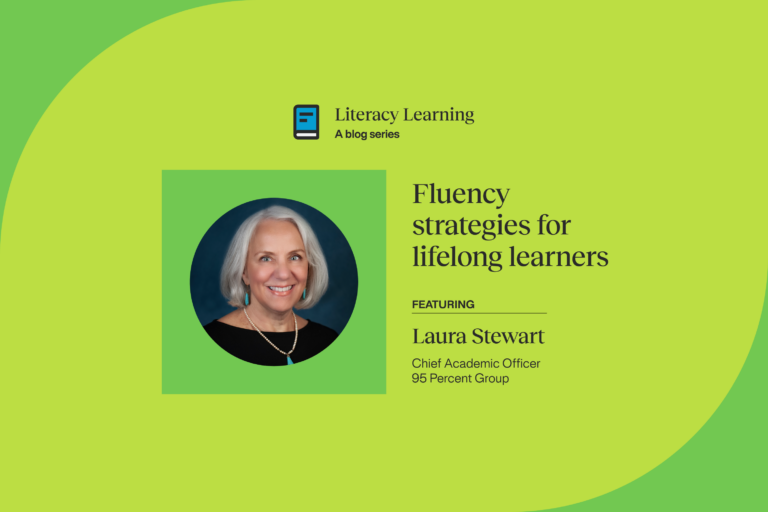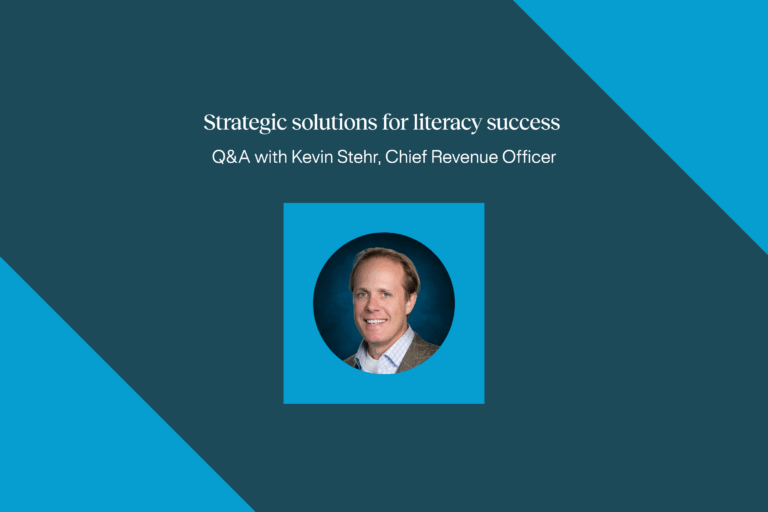Fluency strategies for lifelong learners
A post from our Literacy Learning: Science of reading blog series Written by teachers, for teachers, this series provides educators with the knowledge and best practices needed to sharpen their skills and bring effective science of reading-informed strategies to the classroom.

Reading fluency is defined as “Reasonably accurate reading, with an appropriate rate, with suitable expression, that leads to accurate and deep comprehension and a motivation to read,” according to Jan Hasbrouck and Deb Glaser in their book Reading Fluency: Understand, Assess, Teach (2019). Fluency is a foundational reading skill which allows a student to move from a focus on word recognition to creating the cognitive bandwidth to focus on comprehension.However, fluency is often misunderstood. Some mistakenly believe fluency is only the rate or speed at which children read or spell.
According to Laura Stewart, Chief Academic Officer at 95 Percent Group: “There was a time in which it was believed fluency was all about the speed of reading. We know now that it is all about accuracy, automaticity and prosody (or expression), with accuracy being the most important. As Dr. Jan Hasbrouck, leading researcher, author, and expert on fluency states, when it comes to fluency: ‘Accuracy, first, foremost and forever the foundation of fluency.’”
Fluency starts with understanding the sounds (phonemes) and spellings of those sounds (graphemes) and then progresses into words, phrases, and sentences. Mastering fluency skills plays a key role in unlocking the code to reading and creating lifelong learners. Ahead, we’ll go over the importance of fluency and examine nine science-backed reading fluency strategies designed to help in the education of this pivotal skill set.
Why fluency matters (for all ages)
Countless studies show reading fluency goes hand-in-hand with reading comprehension. Strong readers can typically read texts more fluidly than struggling readers. However, before becoming fluent, readers need both accuracy and reading without hesitation.
“We want students to practice reading words and text with accuracy so that they aren’t reading words incorrectly. Accuracy first is the pathway to fluency,” explains Laura Stewart.
The Importance of fluency for early readers
Fluency is important for early readers because it builds the pathway between speech and print. According to researchers, fluency skills emerge in children anywhere from first to third grade as their decoding skills grow. Research shows that once students can recognize and connect the sounds of spelling correspondence (phonemes) with their correct written correspondence (graphemes), they become orthographically mapped.
“[Orthographic mapping is] the mental process we use to permanently store words for immediate, effortless retrieval,” explains Psychology Professor David Kilpatrick, PhD. in his book Essentials of Assessing, Preventing, and Overcoming Reading Difficulties. “It is the process we use to take an unfamiliar printed word and turn it into an immediately recognizable word.”
While early readers may first appear more fluent in reading because of their spoken vocabulary, they are often still learning the necessary strategies to recognize, spell, and understand unfamiliar words. For example, it’s accurate to say the sound “mmm” is spelled with the letter “M”, but students need to get to a point where it’s automatic for them to know that. Automaticity is key to helping with the speed and accuracy of reading consistently and unintentionally (such as reading a flyer outside a store window while walking past it).
How fluency impacts readers who struggle
Fluency plays an important role for those having difficulty with reading, especially since a report by University of Michigan and Michigan State researchers found that fluency and word recognition issues are believed to account for 90% of students struggling with reading comprehension. Many readers struggling with fluency have difficulties grasping the same skill that early readers are working on: decoding or word recognition. These readers may need additional, explicit instruction, perhaps going back to phoneme awareness instruction. It’s important to keep in mind that these literacy struggles are not limited to a certain grade level or age.
“There are readers who struggle, regardless of grade level. The most important thing is to recognize the area of struggle through accurate diagnostic assessment, then remediate the skill gap so that they can get on track to academic success,” says Stewart.
It is important to note that for some readers who struggle with fluency, it really isn’t a fluency problem; it may go much deeper, all the way back to phoneme-grapheme decoding, and perhaps to phoneme awareness.. Students may face difficulties in distinguishing between phonemes that sound the same. For example, they might mistake the nasal sound “n” for the nasal sound “m” in the word “jump” or they might be confused by liquid sounds like the “r” and “l” in the word “girl”. The issue with blending phonemes and recognizing these allophonic variations, or the differing sounds phonemes can make within different contexts, can be addressed with the same structured literacy instruction early readers receive.
For these students, educators often need to work with them so they’re able to access the individual phonemes and strengthen the connection between each of the sounds and the spelling they represent. This includes lessons on phoneme segmentation or breaking apart the words by their individual sounds, blending phonemes, and phoneme manipulation. From there they may then move to letter-sound correspondences, simple decoding and encoding, and eventually they will have the accuracy to begin to read words and text fluently.
The difference fluency makes for advanced readers
As readers become more advanced, fluency is what is used to free up the cognitive load it takes to read. With readers becoming more accurate and automatic with their reading skills, they’re able to spend more time comprehending the text they’re reading or hearing. An advanced reader who is fluent isn’t just one who can read a piece of text quickly, but one who can read it with expression and a greater understanding.
“Fluency is really the bridge between mastering word recognition and comprehension. The goal is to “read like we speak,” effortlessly and fluidly, so attention can be fully allocated to comprehension. I like to say that fluency is the bridge, and comprehension is the destination” says Laura Stewart.
9 Strategies to boost fluency
Numerous scientifically-backed strategies can help students with their fluency skills. However, it’s important to keep in mind that these strategies are part of a greater goal: to create strong readers and writers.
“Fluency is really an outcome of explicit, systematic instruction combined with intentionally planned and executed practice,” according to Laura Stewart.
It’s important for instructors not to get lost in growing fluency by itself, but to treat fluency as that bridge between word recognition and comprehension. Below are nine strategies to boost fluency and maintain a focus on that end goal.
1. Chunking
Fluency looks different at different grade levels. One strategy is to boost fluency skills through chunking, which is a method to have students decode sentences by breaking them into more manageable chunks. Fluency boxes are a simple, yet effective tool for educators to use for young readers in kindergarten or 1st grade. These fluency boxes help students practice the letter sounds they know by visually separating text into individual letters, words, or chunks. If fluency boxes are not available, instructors can also have students draw brackets or circle sentence parts. Students will then read the letters or words as they sound out loud. If students can’t read them within a few seconds, that will be a sign that they haven’t gained reading fluency yet.
2. Phrase reading
Phrase reading is often referred to as the swoop reading method. As students begin to read, they may sound almost robotic. The goal of phrase reading is to help readers visually see the flow of the sentences they’re reading or saying out loud and improve their reading comprehension and expression skills.
According to the 50 Nifty Activities for 5 Components and 3 Tiers of Reading Instruction, this strategy can be taught in a few different ways:
- Whole classroom instruction: Use whiteboards or chalkboards and have students draw swoops under the phrases within a sentence. If these tools aren’t available, you can also have students take a pencil or use their fingers to swoop some of the words together.
- Small group work: Employ classroom reading interventions and have students break down a two-phrase sentence. The first student will say the first phrase, the second student will say the second phrase, and the third student will say the entire sentence.
- Independent practice: Instruct students to write a sentence on a piece of paper and swoop the sentence. Then have them cut it apart by the phrases and rewrite the sentence.
3. Modeling
Teachers modeling fluency by reading aloud is a critical tool in developing fluency among students. Besides reading fictional books, teachers also need to read informational texts, since students as young as 2nd grade are beginning to recognize informational text structures or the way text is being presented to readers (e.g., compare and contrast or cause and effect).
Elementary school instructors can read picture books but can also read informational picture books such as an article on Iceland or a book on the most dangerous dinosaurs that existed. After reading to students, teachers can then have students read back to them as part of an “I do, we do, you do” strategy.
“The gradual release model is a proven framework for instruction. It starts with the all-important explicit instruction and modeling, followed by guided practice with coaching and monitored independent practice,” explains Stewart.
If you’re not sure what texts to introduce to your students, our Phonics Core Program has both informational and fictional texts available every week. Through 3rd grade these passages are decodable, but students in 4th and 5th will be given actual authentic text to read and comprehend using the strategies they’ve learned.
4. Staged reading
Poetry is a great way to increase fluency because poems are already phrased. Have students read through poems and then perform them in a staged reading with their classmates so they can develop deeper fluency and oral expression. Offering students shorter poems in the beginning will reduce overwhelm.
For younger students, poems such as nursery rhymes including “Hickory Dickory Dock” can be used to easily break down phrases. For older students, instructors can use poets such as Shel Silverstein or look for funny poems like limericks. It’s important to keep in mind that it is less about the type of poem, and more about using poems that can be grouped into simple phrases.
5. Repeated reading
In an “I do, we do, you do” fluency strategy, students can work to build their skills through repetition. Repetition and tracking word counts per minute offer several benefits. Students will be able to see a small, but steady growth each time, and teachers will be able to see if students are improving or struggling.
Students can do these repeated exercises in a few different ways. In a full classroom setting, the instructor will first read through a passage, and then the instructor and students can read the same passage together. Then, the students will read the passage silently to themselves before everyone reads it all together one final time while the instructor tracks how many words the students read.
6. Word recognition
Automaticity is a key strategy to improving fluency and it can often be done by focusing on learning words, specifically tricky parts of words that spell different sounds in different situations such as the “ai” in the word “said.” Despite being spelled differently, the word sounds the exact same as the words “bed” or “red”.
Teachers can encourage students to work on their ability to read smoothly and easily through an activity such as “Words by Heart” from 50 Nifty Activities for 5 Components and 3 Tiers of Reading Instruction. In this activity, students will read a word out loud, tap it out, write it down, and draw a heart over the parts of words that do not follow phonetically-regular, sound-spelling correspondence. They’ll then work with some of their classmates to choose a similar word from each other’s lists and use it in a sentence.
7. Partner reading
For this fluency strategy, have students buddy up and work together on their reading skills to practice their oral reading fluency. Have them go back and forth repeating reading one page or section and then having their partner read the other. Instructors can also have their students read pages together at the same time. It’s important to remember that students should not be paired based on proximity in the classroom but by reading proficiency.
“Partner reading is most effective when structured with assigned partners and a designated amount to read. It is also important that the text used is at a high level of reading accuracy for both readers,”, explains Laura Stewart. “Partner reading also provides an opportunity for the teacher to meet in a small group with her striving readers for more individualized instruction.”
8. Character reading
Chapter books include a lot of character dialogue that can easily become overwhelming for new readers. Another strategy to improve fluency and help students more clearly distinguish separate characters in the text is to give each student a character to read. This will make it so the text no longer sounds the same and students are better able to picture and hear the character who is talking. The strategy will also help students build expression as they witness interpretations of how others picture these characters in their heads.
9. Punctuation expression
Expression isn’t only found within words but within the punctuation. A strategy to build fluency and improve automaticity is to focus on recognizing expressions within punctuation. This simple step of focusing on punctuation will help students better understand sentences and their meanings.
Instructors can teach this strategy through simple printed letters. On paper, show students a letter with three different types of punctuation.
- A!
- A?
- A.
First, read the letters A!, B!, and C! excitedly to the class. Then, encourage them to read the next three together with you (D!, E!, and F!). After that, have them read the next three (G!, H!, I!) all by themselves. Continue down the alphabet and introduce other graphemes with the proper responses such as saying something confusingly with a question mark and something more to the point or serious if it has a period.
Building expression in readers
Expression is an important part of fluency that gives readers the ability to read nuances within the text. This is often referred to as prosody and means not just reading words, but also recognizing aspects such as tone, pitch, and the pace at which the words are meant to be read. It gives students the ability to bring what they’re reading to life in their minds.
When students are young, fictional books written for that age level are very relatable. They’ll take place somewhere kids have been, such as at school or at home and characters will often be doing the same things students do and face some of the same struggles the students are facing. But as students grow and read more complex pieces of work, their expression will need to shift too. One important way to build expression is to read text across genres. For example, the way we read informational text is different from the way we read fiction.
“Expression shifts according to the type of text one is reading. When we teach students to read with appropriate expression it really does become a facilitator of comprehension. When a student reads independently with appropriate expression it is an indicator of comprehension,” says Laura Stewart.
The journey to fluency
Fluency is a key to breaking the code of reading and helping students make that leap forward within their reading journeys. Understanding and making sense of fluency instruction is critical to educators as it is important in helping us create lifelong readers and writers.
“It is truly an exciting milestone when students move beyond a focus on word recognition and into fluent reading. When those words are orthographically mapped for instant and accurate retrieval, when reading becomes more effortless, when students can focus their attention on navigating and making meaning from text. . . there is nothing like it. The world opens up,” says Laura Stewart.
Explicit instruction is vital for students to truly grasp and understand fluency. There are numerous evidence-based materials and activities to help students in the classroom. 95 Percent Group’s Phonics Lesson Library to Top 10 Tools, and 50 Nifty Activities for 5 Components and 3 Tiers of Reading Instruction, offer many approaches to help school districts and their instructors teach fluency in a way that supports unlocking the power of literacy for every child.

Expert Biography
Laura Stewart
Chief Academic Officer
Laura Stewart is a nationally recognized science of reading and structured literacy advocate, author, and expert who is building 95 Percent Group’s thought leadership position in the literacy market. Laura has dedicated her career to improving literacy achievement at leading education companies including The Reading League, Highlights Education Group, and Rowland Reading Foundation.
Sources
Duke, N.K.; Pressley, M.; Hilden, K. Difficulties in reading comprehension. In Handbook of Language and Literacy; Development and Disorders; Stone, C.A., Silliman, E.R., Ehren, B.J., Apel, K., Eds.; Guilford: New York, NY, USA, 2004; pp. 501–520.
Hasbrouck, J., & Glaser, D.R. (2019). Reading fluency: Understand – Assess – Teach – Professional Learning Guide for Leaders Professional Development Book. Benchmark Education.
Hasbrouck, J., & Glaser, D.R. (2012). Reading fluency: Understanding and teaching this complex skill. Austin, TX: Gibson Hasbrouck & Associates.
Hasbrouck, J., & Tindal, G. A. (2006). Oral Reading Fluency Norms: A Valuable Assessment Tool for Reading Teachers. The Reading Teacher.
Hudson, R.F., Lane, H.B., & Pullen, P.C. (2005, May). Reading fluency assessment and instruction: What, why, and how? The Reading Teacher, 58(8), 702-714.
Milankov V, Golubović S, Krstić T, Golubović Š. Phonological Awareness as the Foundation of Reading Acquisition in Students Reading in Transparent Orthography. Int J Environ Res Public Health. 2021 May 19;18(10):5440.
Kilpatrick, David A.. “Essentials of Assessing, Preventing, and Overcoming Reading Difficulties.” (2015).
KUHN MR, STAHL SA. Fluency: A review of developmental and remedial practices. Journal of Educational Psychology. 2003;95:3–21.



